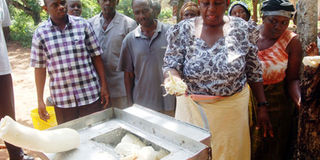Hope for cassava farmers as ethanol brews more options

Basi Mwangaza chair Patience Dhahabu (second left) with the ethanal exctractor in Kilifi. PHOTO / GEORGE KIKAMI / NATION MEDIA GROUP
What you need to know:
- During the production process, Patience explains that a kilo of dried cassava produces a litre of ethanol.
- On a good day, the group manufactures about 20 litres of industrial grade ethanol that sales at Sh300 per litre.
- Currently, they sell the chemicals to schools and dispensaries for laboratory use.
- The women plant drought-resistant cassava from Kenya Agricultural Research Institute that include Tajirika, Karembo and Shibe varieties.
Seated under a mango tree, the group of women in Kilifi County listen to their chairlady carefully as she tells them how to manage their crops.
The chairlady of the chama, Patience Dhahabu, is talking to them about importance of ensuring they keep at bay diseases for good harvest. The women are members of Basi Mwangaza Group and they grow cassava, which they use to make ethanol.
“We produce high grade ethanol from the cassava tubers. We grind the tubers into cassava chips to make the ethanol.”
The 200 members of the chama cultivate cassava stems individually on their farms, and then process it into ethanol. “The county government has donated to us a Sh500,000 mobile motorised equipment, which we use to make the ethanol from starch. They gave us the machine recently. Initially, we were not making the spirit.”
The women harvest and take the tubers to the processing plant. To start ethanol production, the tubers are first cleaned to remove dirt.
Then the skin is removed to remain with the white tubers that are put into a slicing machine. The chips are dried for three days to turn them into golden brown. They are then fermented for a further three days in a tank that has yeast. The mixture is then boiled and the vapour cooled to form ethanol, which is later bottled.
A LITRE OF ETHANOL
During the production process, Patience explains that a kilo of dried cassava produces a litre of ethanol.
On a good day, the group manufactures about 20 litres of industrial grade ethanol that sales at Sh300 per litre.
The group plans to go into mass production. However, they are waiting for quality certification from Kenya Plant Health Inspectorate Service. “Once the certification is issued, we will encourage farmers to venture in the business since there are plans to set up an ethanol factory in the county.”
Currently, they sell the chemicals to schools and dispensaries for laboratory use.
Besides the selling of tubers and ethanol, the women also sell cassava cuttings to other farmers for growing, says Patience, who has a seven-acre farm.
Irine Mwambire, a member of the group, says income from her four-acre farm has enabled her to buy two dairy cows. “I can now depend on cassava to educate my children without looking for bursary assistance.”
In 2012, Patience earned Sh350,000 from the crop and last season, she made Sh670,000. This year, Basi Mwangaza Women Group expect to make Sh2 million.
DROUGHT RESISTANT
The women plant drought-resistant cassava from Kenya Agricultural Research Institute that include Tajirika, Karembo and Shibe varieties.
Compared to other varieties, Karembo has high cyanide content and is the most preferred for ethanol production.
From an acre, cuttings can be harvested five times from mature cassava plants. This takes three years.
Patience says once the cuttings arrive at the collection centre, they are recorded and after sales, the money is paid to members depending on their deliveries.
To grow cassava, disease-free cuttings are inserted into the soil, particularly during the rainy season.
The cuttings can be grown without manure. During its early growth stage, hand weeding is applied for at least three months.
Cassava is affected by pests and diseases that include cassava shoot fly, chinch bugs, cassava mosaic disease, mealy bug, root rot, cassava anthracnose disease and cassava bacterial blight. It matures between eight to 12 months after planting.




